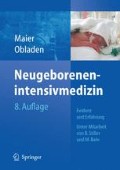Zusammenfassung
Trotz der im vorstehenden Kapitel geschilderten positiven Aspekte stellt die Intensivmedizin in der Neonatologie Eltern, Ärzte und Pflegepersonal oft vor schwere Entscheidungen: Soll bei einem Kind von 23 Wochen eine Intensivtherapie überhaupt begonnen werden? Ist eine künstliche Beatmung bei einem Frühgeborenen mit ausgedehnter Hirnparenchymblutung ohne Anzeichen von Spontanatmung fortzusetzen? Wie lange soll bei schwerer bronchopulmonaler Dysplasie und progredientem Cor pulmonale die Beatmung weitergeführt werden? Verpflichtet uns unser Ethos nicht in bestimmten Fällen zum Abbruch einer intensivmedizinischen Behandlung? Umfragen zeigen, dass Ärzte zu diesen Fragen sehr unterschiedliche Einstellungen haben [5] und dass Eltern mehr als Pflegende zum Weiterführen einer Therapie trotz schlechter Prognose tendieren [26]. Umfrageergebnisse können erheblich von der tatsächlichen Praxis abweichen [23]. Die Vorstellung vom ethisch Gebotenen ändert sich in Europa an den Landesgrenzen. Eine besonders konservative Linie der Lebenserhaltung herrscht in Ungarn, Estland, Litauen und Italien; eine liberale Einstellung, die die zu erwartende Lebensqualität stark berücksichtigt, haben Franzosen, Schweden und Niederländer [20]. In der sich global rasch entwickelnden Neonatologie sind diese Unterschiede ein derzeit nicht aufzulösendes Dilemma.
Access this chapter
Tax calculation will be finalised at checkout
Purchases are for personal use only
Preview
Unable to display preview. Download preview PDF.
Literatur
Arlettaz R, Mieth D, Bucher HU, Duc G, Fauchere JC (2005) End-of-life decisions in delivery room and neonatal intensive care unit. Acta Paediatr 94(11):1626–31
Brown D, Elkins TE (1992) Ethical issues in obstetric cases involving prematurity. Clin Perinatol 19(2):469–81
Bundesärztekammer (2004) Grundsätze zur ärztlichen Sterbebegleitung. 101:A- 1298; B-1076; C-1040
Chiswick ML (1990) Withdrawal of life support in babies: deceptive signals. Arch Dis Child 65(10 Spec No):1096–7
Cuttini M, Casotto V, de Vonderweid U, Garel M, Kollee LA, Saracci R (2009) Neonatal end-of-life decisions and bioethical perspectives. Early Hum Dev 85(Suppl 10):S21–5
Davies JM, Reynolds BM (1992) The ethics of cardiopulmonary resuscitation. I . Background to decision making. Arch Dis Child 67(12):1498–501
Einbecker Empfehlungen (1992) Grenzen ärztlicher Behandlungspflicht bei schwerstgeschädigketen Neugeborenen. Revidierte Fassung. Monatsschr Kinderheilk 140:437–8
Evangelische Kirche Deutschland (2010) Stellungnahme zur Sterbehilfe. EKD, Hannover
Fuchs C (1992) Ethische Trends infolge medizinischen Fortschritts. Dtsch Arztebl 89:B2782–5
Griswold KJ, Fanaroff JM (2010) An evidence-based overview of prenatal consultation with a focus on infants born at the limits of viability. Pediatrics 125(4):e931–7
Hentschel R, Reiter-Theil S (2008) Treatment of preterm infants at the lower margin of viability – a comparison of guidelines in German speaking countries. Dtsch Arztebl Int 105(3):47–52
Ikeda K, Hayashida S, Hokuto I, Kusuda S, Nishida H, on behalf of the Japan Neonatologist Association (2006) Recent short-term outcomes of ultrapreterm and extremely low-birthweight infants in Japan. NeoReviews 7(10):e511–6
Kant I (1785) Grundlegung zur Metaphysik der Sitten. Hartknoch, Riga, BA 66–7
Kant I (1797) Metaphysik der Sitten, Tugendlehre. Nicolovius, Königsberg, A 140
Kassirer JP (1998) Managing care – should we adopt a new ethic? N Engl J Med 339(6):397–8
Katechismus der Katholischen Kirche (1993) Das Leben in Christus, § 2278. Oldenbourg, München, S 580
Kliegman RM, Mahowald MB, Youngner SJ (1986) In our best interests: experience and working of an ethics review committee. J Pediatr 108(2):178–88
Moriette G, Rameix S, Azria E et al. (2010) Naissances très prématurées: dilemmes et propositions de prise en charge. 1ère partie: pronostic des naissances avant 28 semaines, identification d’une zone »grise«. Arch Pediatr 17(5):518–26
Nelson RM, Shapiro RS (1995) The role of an ethics committee in resolving conflict in the neonatal intensive care unit. J Law Med Ethics 23(1):27–32
Pignotti MS, Donzelli G (2008) Perinatal care at the threshold of viability: an international comparison of practical guidelines for the treatment of extremely preterm births. Pediatrics 121(1):e193–8
Platon (1958) Gorgias. In: Grassi E (Hrsg) Platon – Sämtliche Werke, Bd 1, Kap 67. Rowohlt, Hamburg, S 268
Platon (1958) Phaidon. in: Grassi E (Hrsg) Platon – Sämtliche Werke, Bd 1, Kap 12. Rowohlt, Hamburg, S 20
Schulz-Baldes A, Huseman D, Loui A, Dudenhausen JW, Obladen M (2007) Neonatal end-of-life practice in a German perinatal centre. Acta Paediatr 96(5):681–7
Shuster E (1997) Fifty years later: the significance of the Nuremberg Code. N Engl J Med 337(20):1436–40
Silverman WA (1987) Human experimentation in perinatology. Clin Perinatol 14(2):403–16
Streiner DL, Saigal S, Burrows E, Stoskopf B, Rosenbaum P (2001) Attitudes of parents and health care professionals toward active treatment of extremely premature infants. Pediatrics 108(1):152–7
Tyson JE, Parikh NA, Langer J, Green C, Higgins RD (2008) Intensive care for extreme prematurity – moving beyond gestational age. N Engl J Med 358(16):1672–81
Ulsenheimer K (1993) Behandlungspflicht beim Früh- und Neugeborenen aus juristischer Sicht. Z Ärztl Fortb 87:875–80
Verhagen E, Sauer PJ (2005) The Groningen protocol – euthanasia in severely ill newborns. N Engl J Med 352(10):959–62
Verloove-Vanhorick SP (2006) Management of the neonate at the limits of viability: the Dutch viewpoint. BJOG 113(Suppl 3):13–6
Author information
Authors and Affiliations
Editor information
Editors and Affiliations
Rights and permissions
Copyright information
© 2011 Springer-Verlag Berlin Heidelberg
About this chapter
Cite this chapter
Obladen, M. (2011). Grenzen der Neugeborenenintensivmedizin. In: Maier, R.F., Obladen, M. (eds) Neugeborenenintensivmedizin. Springer, Berlin, Heidelberg. https://doi.org/10.1007/978-3-642-01069-9_16
Download citation
DOI: https://doi.org/10.1007/978-3-642-01069-9_16
Publisher Name: Springer, Berlin, Heidelberg
Print ISBN: 978-3-642-01068-2
Online ISBN: 978-3-642-01069-9
eBook Packages: Medicine (German Language)

